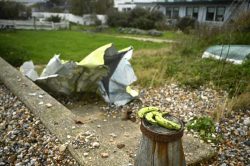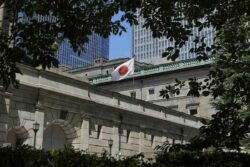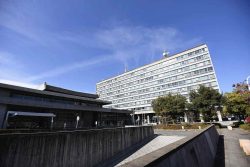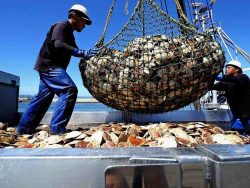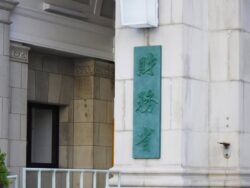15:01 JST, February 27, 2025
Roads, bridges and other infrastructure are aging rapidly. The road cave-in accident that occurred in Yashio, Saitama Prefecture, can be said to have highlighted the fact that sewage pipes are facing the same issue.
The central and local governments must review their methods for inspecting sewage pipes, assess risks at an early stage and nip any large damage in the bud.
The Land, Infrastructure, Transport and Tourism Ministry has set up an expert panel to study how to inspect and manage large-scale sewage systems. An interim report will be compiled by this spring.
The road cave-in accident is believed to have occurred when soil and sand from soft ground flowed into a corroded sewage pipe, causing the road to collapse. In addition to a truck falling into the sinkhole, the accident has caused extensive damage, with about 1.2 million people temporarily asked to refrain from using the sewage system, for example.
The sinkhole is said to be one of the largest ever cave-ins caused by a broken sewage pipe.
The revised Sewerage Law, which came into effect in 2015, requires local governments and other administrators to inspect some sewage systems, which have a larger risk of corrosion, at least once every five years. The pipe at the accident site was judged as “not in need of immediate repair” during a periodic inspection in fiscal 2021.
Since the accident could not be prevented by the conventional inspection method, a review is urgently needed. Anomalies a few meters below the surface of the ground are easy to identify, but it is difficult to survey 10 meters below the surface, as in the case of Yashio. Authorities should review the inspection method, and more frequent inspections should be considered.
In general, it is estimated that it takes around 50 years for infrastructure to deteriorate and need measures to deal with its aging. However, road collapses due to damaged sewage pipes reportedly tend to rapidly increase once the pipes have seen 40 years of use.
In fact, in fiscal 2022, there were about 2,600 cases of road collapses.
Worryingly, the problem is likely to become even more serious in the future. Sewage pipes in Japan run to a total length of about 490,000 kilometers. Pipelines that are over 50 years old currently account for about 7% of the sewage system, a figure that is set to rise to about 19% in 10 years and to about 40% in 20 years.
It has also been pointed out that global warming has raised the temperature inside the pipes, making them more susceptible to corrosion due to the production of sulfuric acid.
It is important to use the latest technologies, such as submersible cameras, drones and artificial intelligence, as it is difficult for people to directly observe these areas.
Another difficult question is how to reduce the cost of maintaining and reconstructing sewage pipes amid tight fiscal conditions for the central and local governments.
In order to reduce the cost of maintaining infrastructure, the central government is working on a shift to “preventive maintenance,” in which work is conducted as early as possible before urgent repairs are required. In the case of sewage pipes as well, it is vital to carefully assess their current condition and promote countermeasures.
(From The Yomiuri Shimbun, Feb. 27, 2025)
"Editorial & Columns" POPULAR ARTICLE
-

Violations of Subcontract Law: Major Automakers Must Eliminate Old Practices
-

Local Governments’ Tax Revenues: Devise Ways to Correct Imbalances in Tax Sources
-

Heavy Rains in Asia: Support for Victims, Flood-Control Measures Urgently Needed
-

5 Japanese Business Dinner Mistakes to Avoid — and What They Taught Me About Business in Japan
-

New Nuclear Threat: China Seeking to Follow U.S., Russia in Military Expansion
JN ACCESS RANKING
-
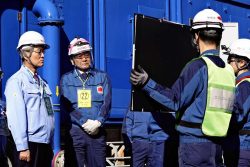
Keidanren Chairman Yoshinobu Tsutsui Visits Kashiwazaki-Kariwa Nuclear Power Plant; Inspects New Emergency Safety System
-

Imports of Rare Earths from China Facing Delays, May Be Caused by Deterioration of Japan-China Relations
-

University of Tokyo Professor Discusses Japanese Economic Security in Interview Ahead of Forum
-

Japan Pulls out of Vietnam Nuclear Project, Complicating Hanoi’s Power Plans
-

Govt Aims to Expand NISA Program Lineup, Abolish Age Restriction


